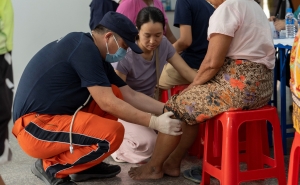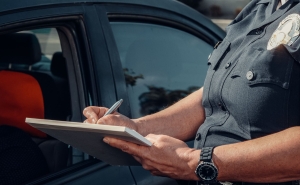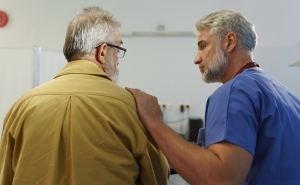Reducing Law Enforcement Violence and Building Trust: Q&A on a Report on Gun Laws in Baltimore

A report, Reducing Violence and Building Trust: Data to Guide Enforcement of Gun Laws in Baltimore, on the enforcement of gun laws in Baltimore finds that a more focused approach could reduce violence and improve community relationships with city police.
Daniel Webster and Cassandra Crifasi, co-authors of the report, explain the background, findings, and takeaways for other communities in the U.S.
What is the background on the report?
Baltimore has long struggled with closely connected problems: extremely high rates of gun violence, policing practices that too commonly harmed members of the communities most impacted by gun violence, and distrust of police.
In 2015, after the death of Freddie Gray from injuries that he occurred while in police custody, these problems came to a head with an uprising that left considerable damage. Homicides and nonfatal shootings increased dramatically immediately after the uprising and have remained at record levels.
In 2016, the U.S. Department of Justice issued a report documenting evidence of unconstitutional policing and abuses, many of which stemmed from BPD policies and practices intended to “get guns off the streets.”
In 2017, eight officers from Baltimore Police Department’s Gun Trace Task Force that had received little internal scrutiny because they brought in many illegal guns were arrested by federal agents for committing an array of serious crimes that included planting guns on suspects.
Why was the study undertaken?
We [the researchers] designed the project to collect and synthesize data that would inform efforts to prevent unconstitutional practices and strengthen the quality of investigations of gun law violations. In addition, the study was undertaken to better understand the perspectives and wishes of community members most heavily impacted by both gun violence and stop and search practices by police.
The report includes findings from three distinct studies: a.) community surveys, b.) community focus groups, and c.) a review of research and reports. What are (some of) the key findings from each?
From the community surveys in parts of East and West Baltimore where gun violence is particularly concentrated, we learned that 77% of residents were concerned about illegal gun carrying in their neighborhood. But the majority of those responding believed that police searched too many people and nearly two-thirds believed that police did not stop individuals who respondents’ saw as the most responsible for crime in the neighborhood.
These themes were also evident in focus group discussions. Many focus group participants did not trust the police to protect them from violent crime and many feared the police as well.
Our review of the research—including research that we have conducted in Baltimore—revealed mixed evidence that unfocused enforcement of gun laws reduced shootings, but consistent evidence that enforcement focused on the highest risk individuals and places did reduce gun violence. Group Violence Intervention (GVI) or focused deterrence programs have been effective in reducing gun violence in many cities. Baltimore’s prior attempts at GVI were hampered by insufficient resources for social supports and problems in implementation.
Our interviews with other law enforcement agencies identified strategies used to reduce biased and unconstitutional practices in the enforcement of gun laws including close tracking of data on each officer’s stops and gun-related arrests and reviews of cases and complaints to identify and correct practices that violate civil rights.
How is gun violence prevention connected to effective policing?
Ready access to firearms, especially in the hands of individuals with a history of violent or reckless behavior, increases the risk of lethal violence. Research shows that restrictions on carrying guns outside the home are associated with reductions in violent crime. When enforcement of those laws is highly focused, the reductions in shootings and homicides is even greater. Research has also found that procedural justice—i.e., the fair enforcement of gun laws—is important in the police and the criminal justice system being viewed as legitimate in the eyes of the community. The more community members view police and the justice system as legitimate, the more likely they are to comply with laws and share information with police that is critical to solving and preventing violent crimes.
What are the key recommendations in the report? / What actions should be taken and by whom?
Key recommendations from the report include:
- BPD should use highly-focused proactive gun law enforcement rather than broad stop and search practices. Focused proactive gun law enforcement should be led by experienced officers, informed by intelligence, and closely supervised.
- To support close supervision and oversight of proactive gun law enforcement, BPD and the State’s Attorney’s Office should develop a robust data-informed system to track illegal gun possession from arrests through to case disposition. The system should be used, along with careful reviews of problem cases, to reduce illegal searches and improve the quality of gun investigations.
- BPD and SAO should make aggregate data on stops, searches, and firearm-related arrests and dispositions (e.g., dismissed due to problems with searches) publicly available.
- The Mayor’s Office of Criminal Justice should work with community-based organizations and academic experts to develop, implement, and evaluate a program to reduce the risk that an individual charged with illegal gun possession commits future crimes of violence.
- Baltimore should implement a focused deterrence program aimed at reducing gun violence that is appropriately targeted, effectively communicated, provides needed services to support nonviolence, involves respected community voices, and delivers swift and certain justice in response to violence.
- BPD and SAO should develop a strategic plan for improving the identification, arrest, and prosecution of shooters that is data driven and informed by the best scientific evidence.
What are the priorities for police accountability and transparency, and what might they look like in practice?
Key priorities include systems for supervisors to track each officer’s stops, searches, citizen complaints, and arrests for illegal gun possession including the dispositions for charges stemming from illegal gun possession. To enhance trust in the police, data from these systems should be shared publicly so that community members could see whether progress is being made in reducing unwarranted stops and illegal searches.
This report is based on data from Baltimore. What are some takeaways for other communities in the U.S.?
Many U.S. cities struggle with high rates of gun violence and use the enforcement of gun laws in attempts to reduce homicides, nonfatal shootings and robberies involving guns. Research conducted in many cities show consistent patterns - broad racially-biased proactive enforcement of gun laws places is harmful to those who are targeted, exacerbates distrust of police and provides uncertain safety benefits.
Our report provides evidence-based recommendations for highly-focused and multi-sector responses to gun violence and police accountability. We hope these are useful to other communities as well.





